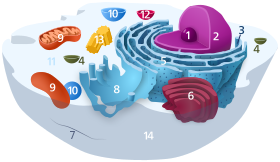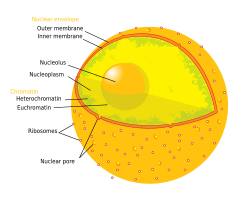Cell nucleus



The cell nucleus (plural: cell nuclei) contains the cell's genes and controls the cell's growth and reproduction. It has a double layered nuclear membrane round it. The nucleus is usually the most prominent organelle in a cell. The nucleus is small and round, and works as the cell's control center. It contains chromosomes which house the DNA. The human body contains billions of cells, most of which have a nucleus.
All eukaryote organisms have nuclei in their cells, even the many eukaryotes that are single-celled. Bacteria and Archaea, which are prokaryotes, are single-celled organisms of a different type and do not have nuclei. Cell nuclei were first found by Antonie van Leeuwenhoek in the 17th century.
The nucleus has a membrane around it but the things inside it do not. Inside it are many proteins, RNA molecules, chromosomes and the nucleolus. In the nucleolus ribosomes are put together. After being produced in the nucleolus, ribosomes are exported to the cytoplasm where they translate mRNA into proteins.
When a cell is dividing or preparing to divide, the chromosomes become visible with a light microscope. At other times when the chromosomes are not visible, the nucleolus will be visible.
Nuclear membrane
[change | change source]Large molecules cannot get through the double-layer nuclear membrane. However, nuclear pores exist. They control the movement of molecules across the membrane. The pores cross both nuclear membranes, providing a channel. The larger molecules are actively transported by carrier proteins, and there is free movement of small molecules and ions. Movement of large molecules such as proteins and RNA through the pores is required for both gene expression and the maintenance of chromosomes.
Nucleolus
[change | change source]Within the nucleus is a structure called a nucleolus. It is made at a nucleolus organizer region (NOR). This is a chromosomal region around which the nucleolus forms. Inside the nucleolus ribosomes are made. These are exported through the nuclear pore complexes to the cytoplasm. There they work to build proteins. They become attached to the endoplasmic reticulum if they are making membrane proteins.[1]
References
[change | change source]- ↑ Cooper, Geoffrey M.; Hausman, Robert E. (2007). The Cell: a molecular approach (4th ed.). Sinauer Associates. pp. 371–9. ISBN 978-0878932207.
